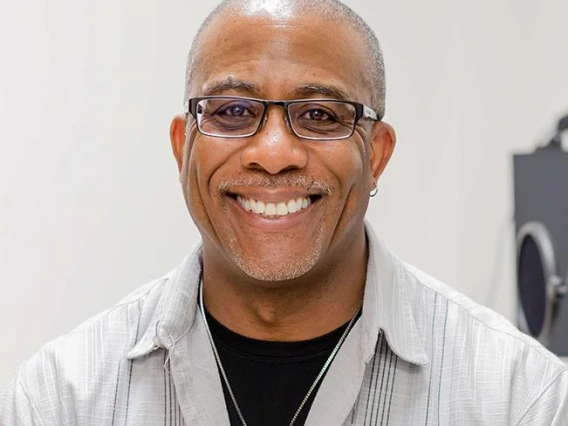
In Bryan Carter’s virtual classroom, online education is moving toward a more immersive and interactive future.
This semester, Carter, director of the University of Arizona’s Center for Digital Humanities and an associate professor of Africana Studies, is launching a three-phase project to transform online teaching and learning, using 360-degree video broadcasting to give students a simulated in-person experience that brings the curriculum to life.
What that means for students in Carter’s Introduction to African-American Literature class (AFAS 160) is a range of experiences, from a virtual face-to-face office-hours conversation, to walking through Paris in the footsteps of expatriate writers like James Baldwin and Richard Wright, or stepping inside virtually recreated landmarks of the Harlem Renaissance.
Awarded a 2019 Distinguished Fellowship from the Center for University Education Scholarship, Carter will advance his project in stages, with each year building on the previous year and exploring increasing levels of immersion. In parallel, Carter will partner with Tech Core to collect data and evaluate the impact of the technology on student outcomes and the potential to extend the technology to other faculty.
“When you think about what online education has been in the past, it’s been an evolution of distance education as originally conceived through correspondence courses. Most have evolved in that sense, taking an advantage of a course management system like D2L, but it’s still really focusing on anytime, anywhere education, as opposed to real-time interaction,” Carter says. “I believe the next evolutionary step is to fully immerse students into an environment that is not only engaging and 360-degree, but also interactive.”
In the spring, Carter will embark on the first year of the project, by incorporating 360-degree video broadcasting into his online course, which will have the effect of personalizing the experience even as he expands the course enrollment to as many as 1,500 students.
“In addition to using Zoom, students will have the option of an immersive experience so that when they put on the headsets, it will feel like they’re right in my office for a one-on-one session,” Carter says. “I believe they will have a different understanding of the course content, perhaps with greater clarity and more interactivity.”
Students aren’t required to use any particular 360-degree headset, which can range from $10 to $400, or any headset at all. Carter expects roughly half of the students to opt for headsets, which will allow him to gather data on how they’re utilizing the interactivity and how that impacts learning.
“Whatever range of headsets that the students choose to use, if they even choose to use, they can do that,” he says. “The study will look at levels of engagement based on the choices the students make.”
In the second year, Carter will build on the first year’s findings, researching how an increase in the interactivity and more immersive virtual environments will impact the course. Carter will be able to surround students in a 360-degree image or video that connects to the course material and the person teaching it.
“It allows us the opportunity to immerse students in a visual landscape that helps reinforce whatever the content of that particular set of readings happens to be,” he says. “If we’re talking about the Harlem Renaissance, I can take them to a venue to help them see and understand that location differently. We can do that with the variety of periods that we study to give students an immersive, visual and interactive learning experience.”
Building on that phase, Carter will next begin transporting students to locations that either don’t exist in the real world at all or have significantly changed over the years.
“Year three will be looking at a computer-generated virtual environment that will have increased interactive possibilities,” Carter says. “It’s only going to get better as the resolution enhances and we’re able to incorporate some semblance of an avatar or figure representation of myself or the students in a computer generated environment.”
Carter’s longstanding Virtual Harlem Project will be expanded and enhanced as part of that phase, taking advantage of technological improvements both in the creation of the digital world and the ability to widely distribute access. By that point, Carter says the student experience will begin resembling the virtual reality vision of science fiction.
“It’s like the alpha version of a Holodeck for those students who are wearing a headset,” he says. “They’ll be taken from my office to Paris or New York and be able to interact with the course material, all from within the headset, like virtual teleportation field trips.”
The research portion of the project will evaluate how best to configure the immersive experience for student learning, and how to translate the technological opportunities to other subjects.
“As the technology continues to increase and evolve, so will the class and we’ll take advantage of those leaps and bounds into iterations of this course,” Carter says. “We’ll use this as a test bed to demonstrate the advanced use of the technology to share with the academic community to replicate as they see fit. Imagine being able to take students in real time to locations around the world that may coincide with any course content.”

